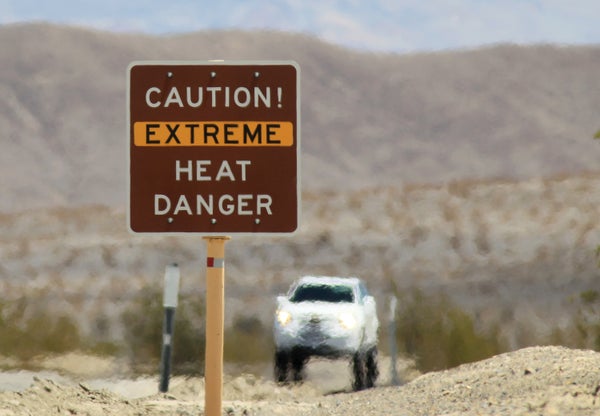This article was published in Scientific American’s former blog network and reflects the views of the author, not necessarily those of Scientific American
Record-setting heat waves in the southeastern United States over the past few weeks offer a sobering reminder that extreme heat is on the rise. Since the 1960s, U.S. cities have experienced more frequent and longer periods of extreme heat. Too often, these have led to tragic results including premature deaths, particularly in older adults, infants, children, and people with chronic diseases. One particularly devastating midwestern heat wave in July 1995 claimed 739 lives in Chicago alone, mostly among elderly, low-income residents.
Increases in heat-related illnesses and hospitalizations affect families and communities as well, with an attendant rise in healthcare costs. And extreme heat endangers the health and well-being of our nation’s 15 million outdoor workers, putting lives, livelihoods and key sectors of the nation’s economy at risk.
Record-setting hot years are projected to become more frequent and intense in the next several decades, with expected extreme temperatures rising to levels well outside of historical experience. How will people in cities across the U.S. be affected? Consider a scenario in which the planet warms by about three degrees Celsius (5.5 degrees Fahrenheit) above preindustrial levels this century. This is the warming expected if the U.S. and other nations meet their modest initial commitments to reduce emissions of heat-trapping gases under the Paris climate agreement.
On supporting science journalism
If you're enjoying this article, consider supporting our award-winning journalism by subscribing. By purchasing a subscription you are helping to ensure the future of impactful stories about the discoveries and ideas shaping our world today.
A recent study we co-authored examined what we can expect from this amount of temperature rise in terms of heat-related deaths in 15 U.S. cities: Atlanta, Boston, Chicago, Dallas, Detroit, Houston, Los Angeles, Miami, New York, Philadelphia, Phoenix, San Francisco, Seattle, St. Louis and Washington, D.C. We looked specifically at the mortality expected to result from the extreme heat events projected to occur once every 30 years on average—that is, at a frequency people can expect to experience two to three times in their lifetimes and for which society should prepare.
We found that, with an increase of three degrees C, a once-in-30-year extreme heat event would lead to nearly 1,350 heat-related deaths per city, on average, assuming today’s population. Chicago, Los Angeles, Miami, New York and Philadelphia face the highest number of fatalities. Miami and Detroit face the highest rates of heat-related mortality because of older and more vulnerable populations.
Our study adds to the evidence that accelerating ambition to reduce emissions and limit temperature rise to well below two degrees C (3.6 degrees F)—the central goal of the Paris Agreement—could prevent thousands of extreme heat-related deaths in cities across the U.S.
Limiting global temperature rise to two degrees C could mean nearly 740 fewer extreme heat-related deaths, on average, across these cities, with 1,980 fewer extreme heat-related deaths in New York City alone. Even more heat-related deaths can be avoided by limiting global temperature increase to 1.5 degrees C (2.7 degrees F).
We can do even better than this. Investments to better prepare for unavoidable extreme heat can, in combination with emissions reductions, prevent nearly all heat-related deaths. Cities can expand municipal systems to provide early warning and response to heat waves to protect the most vulnerable as temperatures rise, ensuring that residents are aware of heat-related health risks and that those with low or fixed incomes have access to air-conditioning supplied, increasingly, by carbon pollution–free sources of electricity. Cities can also begin designing expanded green spaces that provide cooling during hot weather, and buildings, roads and other urban infrastructure that reflect rather than absorb sunlight.
Limiting the public health threat posed by climate change–driven extreme heat requires an unwavering U.S. commitment to ambitious climate leadership. Unfortunately, President Trump has denigrated climate science, rolled back federal initiatives to reduce greenhouse gas emissions, and announced his intent to withdraw the U.S from the Paris Agreement. Through these and other actions, he poses a serious threat to public health.
But elections matter. Public concern about increasing extreme weather and rising seas has dramatically increased since the 2016 election when climate change was barely raised as an issue in the presidential debates. Now, as the 2020 election campaign heats up, voters have a renewed opportunity to ensure that our nation’s leaders are committed to addressing the serious climate challenges we face.
Across American cities, thousands of lives are at stake
